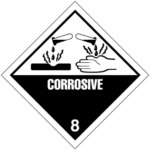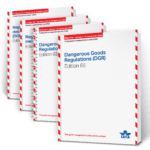This post was originally published in October 2023 and has been updated in November 2024 for accuracy.
Shipping Lead Acid Batteries
Quite a few headlines in the dangerous goods world revolve around lithium batteries. But what about lead acid batteries, are they considered dangerous goods? Do you need UN packaging, hazard class labeling, and placarding when shipping lead acid batteries? First things first, unless there is an exception of some sort, a class 8 corrosive label and a class 8 placard would be required when shipping lead acid batteries. But when it comes to packaging, there is a bit more that needs to be discussed. Let’s take a look at the various domestic and international regulations. For the purpose of this blog, we will be examining Lead Acid Batteries classified as UN2794 which are Batteries, wet, filled with acid.
United States
Per the 49CFR 173.159, lead acid batteries must be packaged in a manner to prevent a dangerous evolution of heat and short circuits. This would include, when practicable, packaging the battery in fully enclosed packaging made of non-conductive material, and ensuring terminals aren’t exposed. UN specification packaging such as 4G fiberboard boxes, various types of drums, and wooden boxes are all compliant to ship lead acid batteries per the 49CFR. If you are shipping by air, a leakproof liner is also a requirement as well. However, non-specification packaging is also allowable provided that the batteries are firmly secured to skids or pallets capable of withstanding shocks among a variety of other requirements located at 173.159 (d), so if you decide to go this route, I suggest you read this section carefully. It Is also important to note that there is an exception when lead acid batteries are transported by highway or rail which would relieve you from the regulations, this is located at 173.159 (e). I would also advise you to read this section carefully as well as this exception can only be used if certain conditions are met.
Canada and IMDG Code
If you are shipping domestically within Canada, we would look at Packing Instruction 801 in the TP14850. Here it says that the lead acid batteries may be handled, offered for transport, or transported in a non-UN Standardized container if the dangerous goods are placed in a rigid container, wooden slatted crate, or on a pallet. In addition, the batteries must be protected against short circuits, and secured to prevent movement. If they are stacked, they must be adequately secured in tiers separated by a layer of non-conductive material, and battery terminals must not support the weight of other superimposed elements. Similarly, the IMDG code sets out similar requirements at Packing instruction P801 when you are shipping internationally by Sea. Using UN packaging would also be acceptable to ship lead acid batteries within Canada as well as by Sea internationally.
IATA
If you are shipping internationally by air, we would look in IATA at Packing instruction 870. In this case, the batteries must be packed in a UN-rated outer packaging such as a 4G box or a drum for example with at least a packaging group II rating per Special Provision A802. In addition, you must also use an acid/alkali-proof liner of sufficient strength and adequately seal it to positively prevent leakage in the event of spillage. The batteries must be packed so that the fill openings and vents, if any, are upward.
Do you have questions about UN packaging for lead acid batteries? Our team of experts is just a call away for our customers at 855.734.5469 or send us an email, we’re happy to help.
Stay up to date and sign up for our newsletter!
We have all the products, services, and training you need to ensure your staff is properly trained and informed.
 UN 4G Battery Shipper UN 4G Battery Shipper |
 Hazard Class 8 Label Hazard Class 8 Label |
 IATA Publications IATA Publications |






 ICC USA
ICC USA ICC Canada
ICC Canada